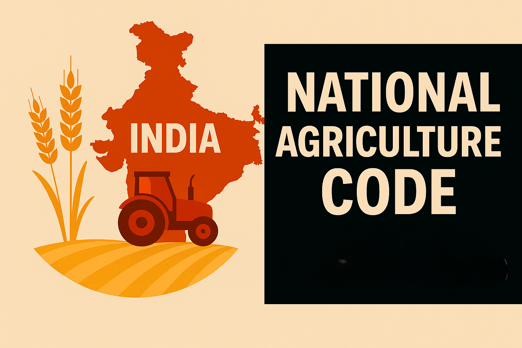WHAT?
The National Agriculture Code (NAC) is a comprehensive framework being developed by the Bureau of Indian Standards (BIS), India’s national standards body under the Ministry of Consumer Affairs, Food and Public Distribution, established under the BIS Act, 2016.
Modeled after the National Building Code (NBC) of 2016 and the National Electrical Code (NEC) of 2023, the NAC aims to establish standardized guidelines for agricultural practices across the entire agricultural cycle.
Announced in 2024, the initiative seeks to enhance productivity, sustainability, and quality in Indian agriculture, addressing gaps in existing standards for machinery (e.g., tractors, harvesters) and inputs (e.g., fertilizers, pesticides) by covering previously unregulated areas like field preparation, micro-irrigation, and water use. The tentative completion date for the NAC draft is October 2025, followed by stakeholder consultations and final release.
Structure of the NAC
The NAC is structured in two parts to ensure comprehensive coverage while accommodating India’s diverse agricultural landscape:
Part 1: General Principles: Provides universal guidelines applicable to all crops, covering processes like crop selection, land preparation, sowing/transplanting, irrigation/drainage, soil health management, plant health management, harvesting/threshing, primary processing, post-harvest operations, sustainability, and record maintenance. Emphasizes modern practices such as natural farming, organic farming, and Internet-of-Things (IoT) applications (e.g., precision agriculture, smart irrigation).
Part 2: Crop-Specific Standards: Focuses on tailored standards for major crops such as paddy, wheat, oilseeds, and pulses, considering India’s 15 agro-climatic zones and socio-economic diversity. Includes input management (e.g., chemical fertilizers, pesticides, weedicides) and post-harvest practices like storage and traceability to ensure quality and safety.
Objectives of the NAC
- Standardization: Create a national framework for agricultural practices that accounts for agro-climatic zones, crop types, and socio-economic diversity, ensuring uniform, efficient, and high-quality farming methods.
- Quality Culture: Serve as a reference for policymakers, agriculture departments, and regulators to integrate NAC provisions into schemes, policies, and regulations, promoting best practices.
- Farmer Empowerment: Provide a comprehensive guide to help farmers make informed decisions, improving crop yields, reducing resource wastage, and enhancing livelihoods.
- Integration with Standards: Align existing Indian Standards (e.g., for machinery and inputs) with recommended agricultural practices to create a cohesive framework.
- Modern Farming: Address emerging areas like SMART farming (using IoT, drones, and data analytics), sustainability, traceability, and documentation to align with global trends.
- Capacity Building: Support training programs through agricultural extension services and civil society organizations to equip farmers with the knowledge and skills to adopt NAC standards.
Key Features and Scope
The NAC covers the entire agricultural value chain, from pre-production to post-harvest stages, with a focus on:
- Agricultural Processes: Standards for crop selection, land preparation, sowing, irrigation, soil and plant health management, harvesting, and threshing.
- Post-Harvest Operations: Guidelines for primary processing, storage, and traceability to minimize losses (estimated at 15-20% of India’s agricultural produce annually).
- Input Management: Regulations for the use of chemical fertilizers, pesticides, and weedicides, alongside promoting organic and natural farming practices.
- Emerging Technologies: Incorporation of IoT, precision agriculture, and sustainable practices to enhance efficiency and reduce environmental impact.
- Regional Customization: Tailored recommendations for India’s 15 agro-climatic zones and diverse soil types to ensure applicability across varied conditions.
Implementation Strategy
- Working Panels: BIS has formed 12-14 expert panels, including university professors, R&D organizations, and industry experts, to draft the NAC. These panels cover specific areas like irrigation, soil health, and smart farming.
- Standardized Agriculture Demonstration Farms (SADFs): BIS is establishing SADFs at select agricultural institutes to test and showcase standardized practices and technologies. These farms will serve as training hubs for farmers, officials, and industry stakeholders.
- BIS has identified 10 prominent agricultural institutes for collaboration, with Memoranda of Understanding (MoUs) signed with two, including Govind Ballabh Pant University of Agriculture and Technology (GBPUAT) in Pantnagar. BIS will provide financial assistance for SADF setup, drawing inspiration from China’s successful model.
- Training Programs: Post-finalization, BIS plans to collaborate with universities and agricultural institutes to train farmers on NAC standards, with financial support to ensure accessibility.
- Timeline: A draft NAC is expected by October 2025, followed by stakeholder consultations (farmers, experts, and policymakers) to refine the code before its final release.
Significance of the NAC
- Productivity and Efficiency: Standardized practices are expected to boost crop yields and reduce losses, addressing India’s low agricultural productivity (e.g., rice yield of 2.6 tons/hectare compared to China’s 4.8 tons/hectare).
- Sustainability: By promoting natural and organic farming, the NAC aligns with environmental goals, reducing the ecological footprint of agriculture (e.g., minimizing pesticide overuse, which affects 20% of arable land).
- Rural Livelihoods: Enhanced practices and training can improve farmer incomes, critical in a sector employing 45% of India’s workforce and contributing 18% to GDP.
- Policy Integration: The NAC will guide schemes like the Pradhan Mantri Fasal Bima Yojana (PMFBY) and e-NAM, ensuring alignment with national priorities like food security and sustainable development.
- Global Competitiveness: By adopting modern technologies like IoT, India can enhance its agricultural exports ($50 billion in FY24) and compete in global markets.
Challenges
- Diverse Agro-Climatic Zones: India’s 15 agro-climatic zones and varied soil types make uniform standardization challenging. The NAC must be flexible to accommodate regional differences.
- State vs. Central Jurisdiction: Agriculture is a State subject under Entry 14 of the State List (Seventh Schedule of the Constitution), potentially leading to conflicts between central BIS standards and state regulations. Harmonizing these while respecting state autonomy is critical.
- Resource Constraints: Smallholder farmers (86% of India’s farmers own less than 2 hectares) may lack access to modern equipment, quality seeds, or irrigation systems to adopt NAC standards.
- Infrastructure Gaps: Limited warehousing, cold storage, and transportation networks (e.g., only 4% of produce is stored in cold chains) could hinder implementation, especially for post-harvest standards.
- Adoption Resistance: Farmers accustomed to traditional practices may resist new standards, necessitating robust extension services and awareness campaigns.


Comments
Write Comment